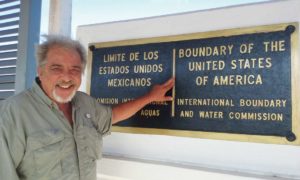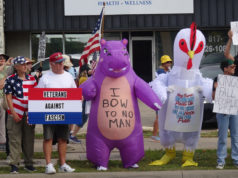
With the money came greed, and where very early on the primary cartels came from a single cartel that had been divided, peaceably and with precise boundaries, the primary cartels began to reach into one another’s territories, triggering a war that began in earnest in the late 1990s, after Carillo’s death, and by the early 2000s had begun to escalate, both in the number of dead and the violence with which they were killed. Much of that was due to a wildcard coming into play. The Zetas, a Mexican paramilitary organization whose leaders had been trained as special forces by the U.S. military to fight the drug war, had changed sides in the late 1990s and become the enforcers for the Gulf Cartel. Their methods were brutal. They left piles of dead bodies on the streets to foster fear. They killed politicians. They caused the nearly 6,500 people of the town of Mier, not far from Matamoros, to abandon their homes and flee for their lives.
The Zetas began to operate as their own cartel in 2007, and by 2010 they could claim 10,000 soldiers under their direction. But the escalation of their violence even before breaking off from the Gulf Cartel and going to war with them was so disturbing that in 2006, newly elected President Felipe de Jesus Calderon Hinojosa ordered the Mexican army to try to eliminate all of the cartels. Taking office on Dec. 1, 2006, Calderon almost immediately put Operation Michoacan into effect, which sent 6,500 military troops into the Mexican state to quell cartel violence there. While that initial military push helped eliminate the smallish Diaz Parada Cartel in Southern Mexico, it only fueled anger among civilians — who were often caught up in the violence — and the larger cartels. By 2007, the military presence in Mexican cities, particularly along the border, was huge, leading to an escalation of violence between the military and the cartels. Where hundreds of people had died annually in the fight over drug money and drug shipping routes prior to the deployment of the military, that number quickly grew to 5,000 deaths in 2008, 10,000 in 2009 and 2010, and as many as 25,000 in both 2011 and 2012. The U.S. Ambassador to Mexico, Carlos Pascual, who resigned in March 2011, attributed the increase in violence directly to Calderon’s military action against the cartels. Additionally, border towns whose residents relied heavily on U.S. visitors for their income were nearly all shut down.
When I visited several of those towns in 2010, Immigration and Customs Enforcement (ICE) agents on the U.S. side of the border opposite the Mexican cities of Matamoros and Reynosa warned us not to make the crossing. ICE also told us that if we had to enter, we should do our business and get out as quickly as possible. At that time, Nuevo Laredo, the site of dozens of major drug war battles, had calmed down, allegedly because the Zeta Cartel had bribed the Mexican government to let them do their business without interference. The bribe had supposedly included both huge sums of money and the promise of no more violence in the streets. But even in Nuevo Laredo, the gringos were missing, and most of the shops and the medical and dental clinics that catered to them were still boarded up and showed signs of recent violence: building walls pockmarked with bullet holes, some buildings simply demolished by grenade launchers, very few people in the streets.
By the time a new Mexican president came into office in December 2012, the drug war was responsible for at least 100,000 deaths and as many as 30,000 disappearances. Enrique Peña Nieto almost immediately began scaling back the military’s role in the drug war, seeking instead to lower the murder and extortion rates while not making a major point of going after the cartel leaders. Peña Nieto’s strategy, or simple weariness from the incessant killing, began to have an effect. While violence continued through 2013 and 2014, it began to noticeably subside two years ago — at least along the border.
Journalist Bill Weinberg (countervortex.org), who has worked extensively in Mexico, agreed in a later conversation with me that the violence has subsided in many border cities.
“To an extent,” he said. “This is a ‘peace of the graveyard.’ The Sinaloa Cartel, the network apparently favored by Mexico’s government and the [U.S. Drug Enforcement Administration], has won its struggle for control of most of the strategic border zone, from Tijuana to Juarez. But in Tamaulipas, on the Gulf Coast, a three-way war continued between local rivals the Gulf Cartel and Zetas and the invading Sinaloa Cartel. This real urban warfare in Matamoros and other Tamaulipas border towns received little news coverage, as the local media were effectively intimidated into silence by the cartels.”
In June 2014, Weinberg explained to me, “there was apparently a summit of narco lords in Piedras Negras, Coahuila, where a ‘Pax Mafiosa’ was negotiated, dividing the influence zones among the rival cartels. This also contributed to a decrease in violence.”
Unfortunately, the peace hasn’t entirely held.
“Two parties to the Pax Mafiosa, the Zetas and the New Generation, have recently been fighting for control of Veracruz, just down the Gulf Coast from Tamaulipas. There’s a sense that the violence is now moving south, into Mexico’s center, now that the border has been mostly secured by the Sinaloa Cartel or divided up by their rivals.
“In any case,” he continued, “given that the violence was approaching genocidal levels — mass murder of abducted migrants, slave labor, mass graves — a decrease in the killing hardly means Mexico is at peace … .”
I didn’t talk about any of that with Chepa or the girls as we made our way to Brownsville for the night, with the plan of heading into Mexico at Nuevo Progreso early the following morning. I thought it better to just wait until the morning. If it felt sketchy, I would just call off the trip. And I would rely on the ICE personnel at the border to let me know if it was safe to enter with two girls.
******











